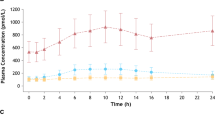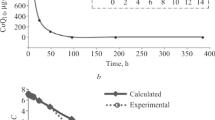Summary
The pharmacokinetic profiles in plasma and the renal elimination of 2-(3-[6-(2-hydroxypropyl)ethylamino]pyridazinyl)ethylcarbazate were investigated in six healthy volunteers following single oral doses of 5, 10 and 20 mg of cadralazine. The study was run in a randomized change-over design experiment. Concentrations of cadralazine in plasma and urine were determined by a high-performance liquid chromatography method.
Maximum plasma levels (Cmax) were reached between 0.25 and 1.0 h (tmax) after administration and ranged from 69.8 to 210.0 ng/g after the 5 mg dose, 148.9 to 333.3 ng/g after the 10 mg dose and 292.9 to 474.5 ng/g after the 20 mg dose. The corresponding area under the plasma concentration-time curve (AUQ*.h) are 330, 621 and 1168 (ng/g). h. Mean renal elimination of the unchanged-drug ranged from 69 t o 73% of the dose. Mean Cmax, AUCfth and mean total renal elimination were linearly dose-related. An elimination half-life from plasma of about 2.5 h was observed for cadralazine. Estimations for the mean renal and total clearance range from 185 to 216 ml/min and 251 to 295 ml/min, respectively.
Similar content being viewed by others
References
Semeraro C, Dorigotti L., Banfi S. and Carpi C. (1981): Pharmacological studies on cadralazine: a new antihypertensive vasodilator drug. J. Cardiovasc. Pharmacol,3, 455–467.
Evans D.A.P. (1969): An improved and simplified method of detecting the acetylator phenotype. J. med. Genet.,6, 405–407.
Hauffe S. and Dubois J.P. (1984): Determination of cadralazine in human plasma and urine by high-performance liquid chromatography. J. Chromatogr.,290, 223–230.
Ludden T.M., McNay J.L., Shepherd A.M.M. and Lin M.S. (1982): Clinical pharmacokinetics of hydralazine. Clin. Pharmacokinet.,7, 185–202.
Van Brummelen P., Bühler F.R., Kiowski W., Bolli P. and Beitel O. (1979): Antipertensive efficacy of a new long acting hydralazine like vasodilator, ISF 2469 in combination with a betablocker and a diuretic. Int. J. Clin. Pharmacol. Biopharm.,77, 380–385.
Simonotti L., Janol M., Parravicini F. and Pifferi G. (1982): Studies on the metabolism of cadralazine in rat. Eur. J. Drug Metab. Pharmacokinet.,7, 39–45.
Carpi C, Dorigotti L. and Semeraro C. (1981): Cadralazine and its identified metabolites: Comparative effects on blood pressure and on arterial smooth muscle. Br. J. Pharmacol.,72, 188P-189P.
Schütz H., Faigle J.W., Küng W. and Theobald W. (1985): Disposition and pharmacokinetics of cadralazine and individual metabolites in man. Eur. J. Drug Metab. Pharmacokinet.,10, 147–153.
Author information
Authors and Affiliations
Rights and permissions
About this article
Cite this article
Hauffe, S.A., Dubois, J.P. & Imhof, P.R. Human pharmacokinetics of cadralazine: A new vasodilator. European Journal of Drug Metabolism and Pharmacokinetics 10, 217–223 (1985). https://doi.org/10.1007/BF03189745
Received:
Published:
Issue Date:
DOI: https://doi.org/10.1007/BF03189745




